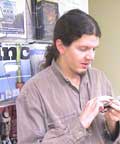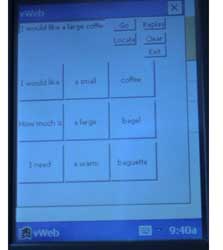Wireless Assistive Services for People with Speech Disabilities
April 8, 2003 / By Doug Ramsey
 |
|
Paul Blair
Postgraduate Researcher, Calit² |
4.8.03 - Assistive technologies for people with disabilities have been around for sometime. Celebrated physicist Stephen Hawking, for example, made speech synthesizers famous some 20 years ago.
But such technology, even today, tends to be proprietary, a code word for very expensive, large and heavy, and not very portable. Because the devices tend to be unwieldy, they can also get damaged easily, requiring down time for repair or replacement, and temporary, but inconvenient, lack of access to the capability for the person affected.
Paul Blair, a postgraduate researcher at Calit², has developed a prototype capability that addresses all aspects of this problem: A portable, low-cost speech synthesizer system that runs on wireless-enabled, commodity PDAs. Blair has enhanced the text-to-speech capability by developing a series of custom "buttons" that can be tapped by the user to quickly form spoken words to convey common thoughts or basic needs, like ordering in a campus café. Current capabilities include the ability to type text or tap the buttons on a PDA, which information can be sent wirelessly to a server, with the resulting synthesized speech played back on the PDA.
|
Better yet, this work leverages the ActiveCampus software developed by Bill Griswold, professor in Computer Science and Engineering and UCSD layer leader for Interfaces and Software Systems, leading to an obvious name for the prototype: AssistiveCampus. Using the user location determination capabilities of ActiveCampus, Blair has enabled the communication buttons to be updated accordingly. "The types of things you say in the coffee shop versus the library are completely different," he notes. ActiveCampus also displays the identity of nearby users also registered with the system. Blair is working on using this information to update the buttons as well. He notes that "conversations are, arguably, most dependent on the persons(s) with whom you are speaking. It is this aspect of the system which could make the greatest contribution to the field of augmentative and alternative communications."
Blair is most interested in the notion of ubiquity. "How do you make communications ubiquitous for people with speech disabilities?" he asks. "In order to be universally accessible, both geographically and economically, I want my application to run on as many different wireless commodity consumer electronic devices as possible."
The application already runs on the iPAQ and a previous generation of HP Jornada - the kind that would "probably sell for about $50 on EBay," says Blair. He wants to port the software to cell phones, which he describes as "the ultimate devices for affordability and universal access" since you can often obtain them for free by signing a service agreement of sufficient length.
"And this is not just about face-to-face communication," explains Blair enthusiastically. "I can imagine people with speech disabilities in city parks in San Diego and London communicating using this technology. You can think of it as a mobile 'assistive chat room.'"
Bluetooth could be a big help to extend the usefulness of the technology, says Blair, by providing a short-range wireless link within one's personal space to access needed assistive I/O - a keyboard, customized buttons, a Braille output display, a speaker to provide audio (instead of text) output, and so forth. "If the distance is short, you could have wireless access at very low power using Bluetooth," says Blair.
The technology is also extensible in that it can be configured to address individual users' needs as well as other disabilities.
Blair is seeking funding from industry and private foundations to support further development. "User trials represent the next logical step," he says. "I want to get the app out in the field to see what we haven't thought about as a guide to further development. I'd also like to involve medical doctors, particularly rehabilitation specialists."
And, given that San Diego is already the 7th most "wireless" city in the country according to a recent survey by Intel not to mention a very popular tourist and convention destination, Blair is hopeful the Chamber of Commerce and other civic-minded community groups might be willing to provide support.
"We have a campus testbed already, but why not extend it to popular tourist haunts like Balboa Park and the Gaslamp District?" asks Blair. "We have a unique opportunity to showcase our approach to assistive technologies that work anytime, anywhere. You could imagine a tourist standing on corner calling a cab and explaining where to be picked up using this application."
Or the application might be customized for real-time bus scheduling or notification of bus delays. For example, the application could be tailored to serve people with physical disabilities to alert a bus driver in advance and the fact that it will require more time to board the bus. This information could then be relayed to central scheduling where the real-time bus schedule could be modified and made available to other bus riders wondering when the next bus will arrive at their stop.
"We have various projects underway that integrate a wide variety of technologies - 802.11b, Bluetooth - with companies like Ericsson and Qualcomm," says Blair. "With the wealth of resources, equipment, and expertise Calit² has, we have the potential to make a revolutionary contribution in the assistive technologies 'space.'"
|
|


